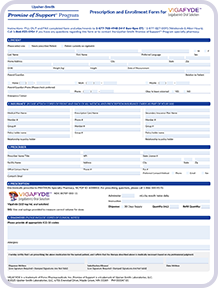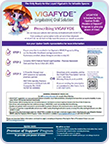WARNINGS & PRECAUTIONS
- Permanent Vision Loss. VIGAFYDE can cause permanent vision loss. The risk of vision loss increases with increasing the dose and cumulative exposure, but there is no dose or exposure known to be free of risk of vision loss. Patient response should be periodically assessed. Patients can be affected with bilateral concentric visual field constriction ranging in severity from mild to severe. Severe cases may be characterized by tunnel vision, which can result in disability. VIGAFYDE also can damage the central retina and may decrease visual acuity. Symptoms of vision loss from VIGAFYDE are unlikely to be recognized by patients or caregivers before vision loss is severe. Vision loss of milder severity, while often unrecognized by the patient or caregiver, can still adversely affect function.
- Monitoring of Vision. Monitoring of vision by an ophthalmic professional with expertise in visual field interpretation and the ability to perform dilated indirect ophthalmoscopy of the retina is recommended. Because vision testing in infants is difficult, vision loss may not be detected until it is severe. For patients receiving VIGAFYDE, vision assessment is recommended at baseline, at least every 3 months while on therapy, and about 3 to 6 months after the discontinuation of therapy. Once detected, vision loss due to VIGAFYDE is not reversible. It is expected that even with frequent monitoring, some patients will develop severe vision loss.
- Magnetic Resonance Imaging (MRI) Abnormalities in Infants. Abnormal MRI signal changes have been reported in some infants with infantile spasms receiving vigabatrin. These changes generally resolved with discontinuation of treatment.
- Neurotoxicity. Intramyelinic edema (IME) has been reported in postmortem examination of patients being treated for infantile spasms with vigabatrin. IME has been seen in animals at doses within the human therapeutic range.
- Suicidal Behavior and Ideation. VIGAFYDE is approved for use in patients 1 month to 2 years of age [see Indication]. VIGAFYDE is not approved for use in adolescents or adults. Antiepileptic drugs (AEDs), including vigabatrin, increase the risk of suicidal thoughts and behavior in adolescents and adults. Patients treated with any AED for any indication should be monitored for the emergence or worsening of depression, suicidal thoughts or behavior, and/or any unusual changes in mood or behavior.
- Withdrawal of AEDS. VIGAFYDE should be withdrawn gradually.
- Anemia. VIGAFYDE may cause anemia.
- Somnolence and Fatigue. VIGAFYDE causes somnolence and fatigue.
- Weight Gain. VIGAFYDE causes weight gain in pediatric patients.
DRUG INTERACTIONS
VIGAFYDE may decrease phenytoin plasma levels; dosage adjustment may be needed.
ADVERSE REACTIONS
- In patients with Infantile Spasms (incidence >5% and greater than on placebo): Somnolence, bronchitis, ear infection, and acute otitis media.
The most serious adverse reactions are listed above in the WARNINGS AND PRECAUTIONS section.
Refer to the DOSAGE AND ADMINISTRATION section of the full Prescribing Information for recommended dosing guidelines for VIGAFYDE.
VIGAFYDE is a concentrated solution as compared to other vigabatrin products. Verify strength and the dose of the product prior to prescribing, dispensing, and administering. VIGAFYDE does not require additional reconstitution or dilution prior to administration.
This safety information is not comprehensive. Please refer to the full Prescribing Information, including Boxed Warning for vision loss, WARNINGS AND PRECAUTIONS and Medication Guide. You can also visit www.VIGAFYDE.com, www.upsher-smith.com or call 1-888-650-3789.
You are encouraged to report suspected adverse reactions to Upsher-Smith Laboratories, LLC at 1-855-899-9180 or to the FDA by visiting www.fda.gov/medwatch.





